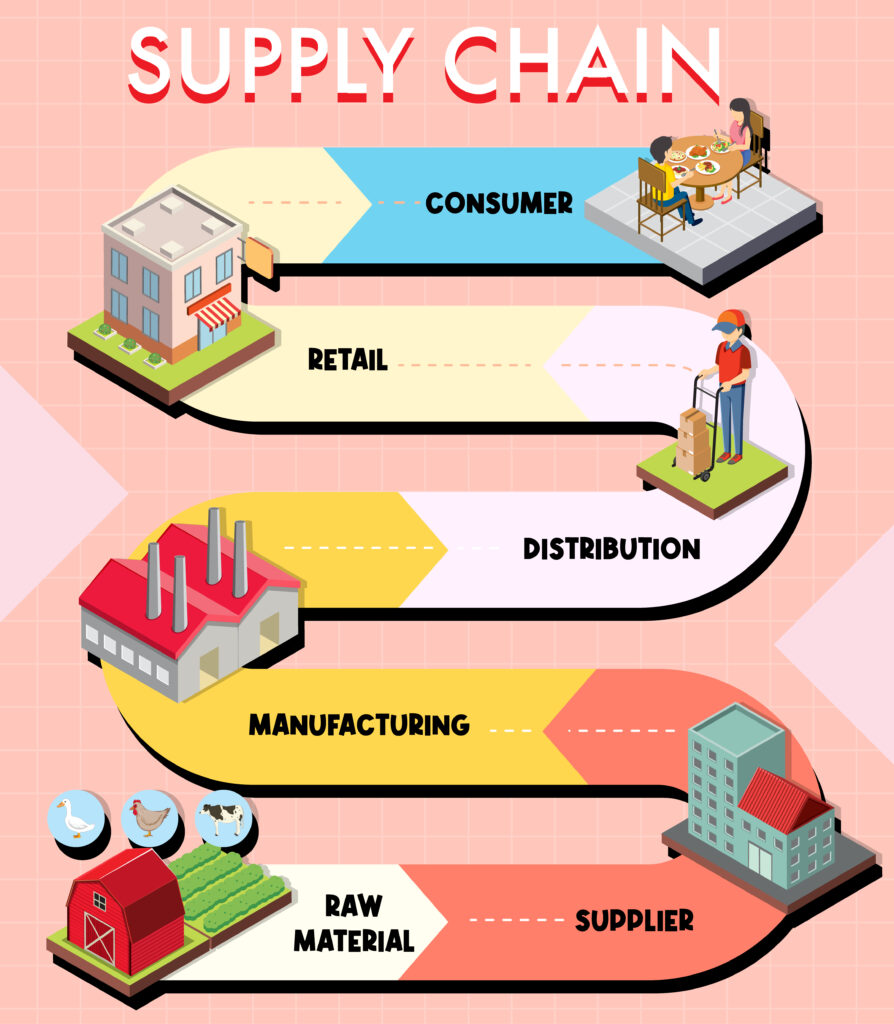Introduction
The ever-evolving landscape of the global economy brings forth several emerging trends that significantly impact domestic supply chains. As markets continue to expand across borders, businesses must navigate through complex challenges while seizing promising opportunities. In this blog, we will uncover the latest domestic supply chain trends across the globe, providing valuable insights into the realm of business.
What is a Supply Chain?

The supply chain is the end-to-end process of planning, coordinating, and executing the inflow of goods and services from the source to the end user, that is, the customer. SCM involves various activities such as sourcing, production, distribution, logistics, inventory management, quality control, and customer service. SCM aims to optimize the efficiency, effectiveness, and sustainability of the supply chain while meeting customer needs and expectations.
A brief history of past global supply chain trends
The global supply chain has undergone significant changes in the past few years, especially due to the COVID-19 pandemic, which disrupted the normal operations of many industries and markets. Some of the past global supply chain trends that have shaped SCM include:
· The rise of e-commerce and omnichannel retailing, which increased the demand for faster and more flexible delivery options.
· The adoption of digital technologies and platforms, such as cloud computing, artificial intelligence, blockchain, and the Internet of Things, enabled more visibility, collaboration, and automation across the supply chain.
· The shift to regional and local sourcing, manufacturing, and distribution, which reduced the dependence on global suppliers and mitigated the risks of trade wars, tariffs, and geopolitical conflicts.
· The focus on environmental, social, and governance (ESG) factors, which increased awareness and accountability of the supply chain’s impact on society and the planet.
Major global supply chain trends in 2023
In 2023, these trends are expected to continue and evolve, along with some new ones that will pose new opportunities and challenges for SCM. Some of the key trends in supply chain management and logistics in 2023 are:
· The integration of physical and digital supply chains, which will create a seamless and responsive network that can adapt to changing customer demands and market conditions.
· The adoption of advanced analytics and automation to enhance the decision-making and execution capabilities of the supply chain by leveraging data, algorithms, and robotics.
· The emergence of smart operations, which will extend the conception of smart manufacturing to encompass all core functional capabilities, including service and logistics.
· The development of mobile capital optimization, which will maximize the use of an enterprise’s mobile means by combining business process software, sensitive technologies, and functional exploration ways.
· The implementation of actionable AI, which will deliver better data-driven decisions by mimicking the problem-solving that humans do by augmenting decisions and keeping humans in the loop for validation purposes.
These trends are driven by the need to improve the efficiency, agility, resilience, and sustainability of the supply chain in a dynamic and uncertain environment.
Technology trends in the global supply chain in 2023:
Some of the technological developments that support these key trends are:
· Cloud computing: Cloud computing enables the supply chain to access and share data and applications across different devices, locations, and platforms. Cloud computing also provides scalability, flexibility, and cost-effectiveness for the supply chain. According to a report by Gartner, cloud-based supply chain applications will account for 65% of total spending on supply chain technology by 2023.
· Artificial intelligence: AI can help the supply chain to optimize processes, reduce costs, enhance quality, and increase customer satisfaction. According to a report by IDC, global spending on AI systems for supply chain management will reach $8.8 billion by 2023, with a compound annual growth rate (CAGR) of 25.5%.

· Blockchain: Blockchain can help the supply chain improve traceability, accountability, and trust among stakeholders. Blockchain can also enable smart contracts, which are self-executing agreements that can automate transactions and enforce rules. According to a report by MarketsandMarkets, the global blockchain supply chain market size is expected to grow from $253 million in 2020 to $3.4 billion by 2026, at a CAGR of 53.2%.
· Internet of Things: IoT can help the supply chain monitor and control assets, processes, and environments in real-time. IoT can also provide insights and alerts that can improve performance, safety, and efficiency. According to a report by Grand View Research, the global IoT in supply chain management market size is expected to reach $94.9 billion by 2025, at a CAGR of 24.5%.
These are some of the technology trends that will shape the future of supply chain management in 2023 and beyond.
Challenges ahead for global supply chain management
The global supply chain management system is confronting and must overcome several obstacles as a result of these trends. Some of these challenges are:
The persistence of logistics disruptions will continue to affect the availability and cost of transportation modes such as sea freight, air freight, rail freight, and road freight.
· The volatility of material scarcity and commodity prices will impact the access and affordability of key inputs such as semiconductors, metals, plastics, chemicals, and energy.
· The difficulty of demand forecasting, which will increase the uncertainty and complexity of planning and managing inventory levels and production schedules.
· The pressure of ESG compliance and reporting, which will require more transparency and accountability from the supply chain on its environmental footprint, social impact, and governance practices.
How the global supply chain can be future-ready
To overcome these challenges effectively, various stakeholders in SCM need to work together and adopt some solutions, such as:
· For governments: Providing policy support and incentives for supply chain innovation and sustainability; facilitating trade cooperation and integration; enhancing infrastructure development and security; promoting skills development and education for SCM talent.

· For businesses: Aligning SCM strategies with corporate goals and customer expectations; fostering a culture of innovation and learning; embracing digital transformation; engaging with suppliers and partners on ESG issues; empowering employees with data and tools.
· For consumers: Being aware of the impact of their consumption choices on the supply chain; demanding more transparency and accountability from businesses; supporting sustainable products and practices; providing feedback and suggestions for improvement.
Some global supply chain leaders have taken measures to deal with these challenges by adopting various strategies, which include:
· Re-designing alternative supply chain flows that can reduce bottlenecks and increase resilience.
· Diversifying supplier portfolios that can mitigate concentration risks and enhance sourcing flexibility.
· Investing in digital capabilities that can improve visibility, collaboration, and agility across the supply chain.
· Implementing circular economy principles that can reduce waste, extend product life cycles, and create value from by-products.
Future trends and challenges for the global supply chain
Looking ahead to the future beyond 2023, several potential trends and challenges can be anticipated for the global supply chain. Here are some key points to consider:
The rise of new business models that leverage platforms, ecosystems, networks, communities, co-creation, personalization, and servitization.
· The emergence of new technologies that enable new capabilities such as quantum computing, biotechnology, nanotechnology, and 3D printing.
· The evolution of customer expectations that demand more convenience, customization, quality, and value.
· The escalation of global risks that pose threats such as climate change, pandemics, cyberattacks, terrorism, and social unrest.
Conclusion
The current state of the global economy is still fragile and uncertain due to the ongoing effects of the COVID-19 pandemic and geopolitical and geoeconomic tensions. However, there are also opportunities for the global supply chain to recover, grow, and thrive by leveraging the trends and solutions discussed above.
Blog by Amith Raj
















